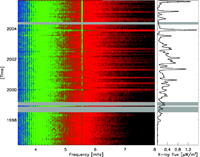SOHO confirms 36 year old solar theory
17 April 2008
Data from the VIRGO instrument on SOHO have been used to show that solar flares drive global oscillations in the Sun. This confirms a prediction made more than 30 years ago. The result has implications for our understanding of flares on the Sun and on solar-like stars.In a paper to appear in the 1 May issue of The Astrophysical Journal Christoffer Karoff and Hans Kjeldsen, from the University of Aarhus, Denmark, show that there is a strong correlation between the energy at high frequency in the solar acoustic spectrum and the appearance of solar flares.
Ten years of data from the VIRGO instrument on SOHO is used to construct frequency/time diagrams of integrated sunlight. The temporal behaviour of solar flares, for the same period, is represented by the 1-8 Å X-ray flux measured by the GOES satellite.
 |
|
Frequency/time diagram of integrated sunlight from VIRGO data (left). Bright, horizontal lines are strongly correlated with solar flares, represented by the X-ray flux measured by GOES (right). |
Analysis of the data shows a strong correlation between the energy at high frequencies (above 5.3 mHz) and the appearance of solar flares. As the number of solar flares increases so too does the strength of the high-frequency oscillations.
The idea that solar flares could excite free global oscillations in the Sun was proposed in the early 1970’s. The phenomenon is similar to what happens on Earth in the aftermath of a large earthquake. A recent example is the 2004 Sumatra-Andaman Earthquake; this quake set the Earth ringing for several weeks afterwards. The Karoff and Kjeldsen study shows that this is also true for the Sun.
The authors note that it is still not clear exactly what mechanism can explain how solar flares excite the high-frequency oscillations.
This result will bring new insight into the phenomenon of solar flares. It may also be applicable to studies of solar-like stars. High-frequency waves have already been detected in beta Hydri and in alpha Cen A & B (Karoff 2007). If telescopes, such as COROT or Kepler, can measure the time variation of the amplitude of these waves then it may be possible to infer the existence of flares on these stars.
Related publications:
Karoff, C. & Kjeldsen, H., "Evidence That Solar Flares Drive Global Oscillations in the Sun", The Astrophysical Journal, Volume 678, Issue 1, pp. L73-L76, 2008 May 1, DOI: 10.1086/588466
Karoff, C. "High-frequency modes in solar-like stars", Monthly Notices of the Royal Astronomical Society, Volume 381, Issue 3, pp. 1001-1008, 2007, DOI:10.1111/j.1365-2966.2007.12340.x
